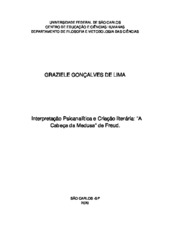| dc.contributor.author | Lima, Graziele Gonçalves de | |
| dc.date.accessioned | 2021-01-19T19:11:37Z | |
| dc.date.available | 2021-01-19T19:11:37Z | |
| dc.date.issued | 2020-11-09 | |
| dc.identifier.citation | LIMA, Graziele Gonçalves de. Interpretação psicanalítica e criação literária: “A cabeça da Medusa” de Freud. 2020. Dissertação (Mestrado em Filosofia) – Universidade Federal de São Carlos, São Carlos, 2020. Disponível em: https://repositorio.ufscar.br/handle/ufscar/13719. | * |
| dc.identifier.uri | https://repositorio.ufscar.br/handle/ufscar/13719 | |
| dc.description.abstract | The Medusa’s Head is a posthumous article published in 1940, although it was written in
1922. In this manuscript, Freud performs the psychoanalytical interpretation of a
mythological symbol. It is possible to find other mentions about Medusa in published articles,
for example, some aspects are pointed out in The Infantile Genital Organization (1923) when
Freud examines the “sexual difference”, the figure also appears in the 29th conference:
Review of the theory of the dream (1933). Freud, by commenting on some images that are
frequently present in dreams that express the fear of castration, places the mythological
figure of Medusa's head as one of the representations of this dread. In this dissertation we
seek to discuss The Medusa’s Head (1922 [1940]), supporting us in some reinterpretations
of the myth to elucidate, from the technical point of view, how it is possible to carry out the
interpretation of a mythological narrative. The investigation was divided into the following
segments: Literary creation and its relationship with fantasy; the uncanny in the literature
and in the head of Medusa and the development of child sexuality. As a final part, we
highlight Medusa's figurations, especially the strong association between feminine and
horror. We conclude that considering Freud's statement that the artist has access to the laws
of psychic processes and manages them to transmit on his works something of his
unconscious fantasies, with myths, literature, and art, we can have access to a symbolism
that for the subject is full of meaning. | eng |
| dc.description.sponsorship | Conselho Nacional de Desenvolvimento Científico e Tecnológico (CNPq) | por |
| dc.language.iso | por | por |
| dc.publisher | Universidade Federal de São Carlos | por |
| dc.rights | Attribution-NonCommercial-NoDerivs 3.0 Brazil | * |
| dc.rights.uri | http://creativecommons.org/licenses/by-nc-nd/3.0/br/ | * |
| dc.subject | Psicanálise freudiana | por |
| dc.subject | Cabeça da Medusa | por |
| dc.subject | Interpretação psicanalítica | por |
| dc.subject | Freudian psychoanalysis | eng |
| dc.subject | Medusa´s head | eng |
| dc.subject | Psychoanalytic interpretation | eng |
| dc.title | Interpretação psicanalítica e criação literária: “A cabeça da Medusa” de Freud | por |
| dc.title.alternative | Psychoanalytic interpretation and literary creation: "Medusa's head” by Freud | eng |
| dc.type | Dissertação | por |
| dc.contributor.advisor1 | Namba, Janaina | |
| dc.contributor.advisor1Lattes | http://lattes.cnpq.br/5016873975206205 | por |
| dc.description.resumo | A cabeça da Medusa é um artigo póstumo publicado em 1940, apesar de ter sido escrito em 1922. Nesse manuscrito, Freud realiza a interpretação psicanalítica de um símbolo mitológico. É possível encontrar outras menções à Medusa em artigos publicados, por exemplo, alguns aspectos são apontados em Organização genital infantil (1923) quando Freud se debruça sobre a “diferença sexual”, a figura também aparece na 29ª conferência: Revisão da teoria do sonho 1933, Freud ao comentar algumas imagens frequentemente presentes nos sonhos que expressam o medo da castração situa a figura mitológica da cabeça da Medusa como uma das representações desse pavor. Na presente dissertação buscamos discutir A cabeça da Medusa (1922 [1940]) nos amparando em algumas releituras do mito com o objetivo de elucidar do ponto de vista da técnica, como é possível realizar a interpretação de uma narrativa mitológica. A investigação se dividiu nos seguintes eixos: Criação literária e as relações com a fantasia; o inquietante na literatura e na cabeça da Medusa e desenvolvimento da sexualidade infantil. Como parte final destacamos as figurações de Medusa, sobretudo a forte associação entre feminino e horror. Concluímos que diante da constatação de Freud de que o artista tem acesso às leis dos processos psíquicos e consegue transmitir em suas obras algo de suas fantasias inconscientes, através dos mitos, da literatura e da arte podemos ter acesso a um simbolismo que para o sujeito é repleto de sentido. | por |
| dc.publisher.initials | UFSCar | por |
| dc.publisher.program | Programa de Pós-Graduação em Filosofia - PPGFil | por |
| dc.subject.cnpq | CIENCIAS HUMANAS::FILOSOFIA::EPISTEMOLOGIA | por |
| dc.description.sponsorshipId | CNPq: 133028/2018-6 | por |
| dc.publisher.address | Câmpus São Carlos | por |
| dc.contributor.authorlattes | http://lattes.cnpq.br/4967536542415230 | por |


